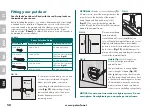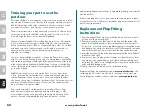
60
www.petsafe.net
FI
SV
DA
NO
RU
EN
Training your pet to use the
pet door
Most pets will learn to use the pet door almost at once but there are a few
who may be a little nervous at first. The following tips will help your pet to
take full advantage of the outdoor freedom and indoor comfort - which
you want for your pet – and which your new pet door provides.
The most important rule is to be patient with your pet. Don’t be in a hurry.
Let your pet work out for itself that it can go in and out of doors. Don’t
force it through the flap or it may become frightened.
Many pet owners install pet doors when they move house. If this applies
to you, make sure that your pet is familiar with his or her surroundings
before you fit the pet door. Take it on supervised trips outdoors on a lead
and make sure it also feels secure and comfortable in its new indoor
environment. Cats especially can develop long lasting fears in
unfamiliar surroundings.
Once you have installed your pet door, leave the flap open for some
time. You can do this by using a long strip of masking tape; open the flap
and use the tape to keep it held open by fixing the other end of the tape
to the surface above. Make sure that the fixing is secure so that the flap
can not fall down accidentally. Let your pet become familiar with it and
go in and out freely.
Establish a motive for your pet to use the door. For cats, a good one
is food. First feed the cat near the door, inside and then near the door
outside. Repeat as often as you need to. Most cats, especially kittens,
also have a strong urge for freedom, perhaps to hunt. Cats are also social
creatures - they enjoy the company of other cats. This can be another
reason for them to explore outside.
Dogs can be trained to use the pet door in a matter of hours. Dogs
respond to encouragement, repetition and especially play, so why
not use the door as part of a game? E.g. throwing a ball through the
pet door. Pat and congratulate the dog when the pet door is used
appropriately. Repeat several times congratulating the dog every time he
uses the pet door.
If this is something new to your pet, it may take some patience to teach
your pet how to use it. When your pet makes progress give them a lot of
praise - they’ve earned it!
Replacement Flap Fitting
Instructions
1. From the inside of the house, ensure that the 4-way locks are in the off
position (to allow entry and exit).
2. Firmly but carefully, prise the hinges on the flap from the inside of the
frame. You may find it easier to remove the pet door from your door to
do this. If so, you should remove the blanking plugs to reveal the screws
and binder posts, which you should unscrew. Once removed, the inside
frame will come away from your door and the flap can be removed.
3. Insert the new flap into the inside frame ensuring that the word PetSafe
®
reads from left to right.
4. If necessary, reposition the pet door frames, into the hole in your door
and use the screws and binder posts to clamp and secure firmly back
into place. Be careful not to overtighten the screws. Re-cover the screw
holes with the blanking plugs.
5. Finally, reposition the 4-way locks to the desired setting.
Replacement flaps are available online at
www.petsafe.net
or by
contacting the Customer Care Centre. For a listing of Customer Care
Centre telephone numbers, visit our website at
www.petsafe.net
.





































